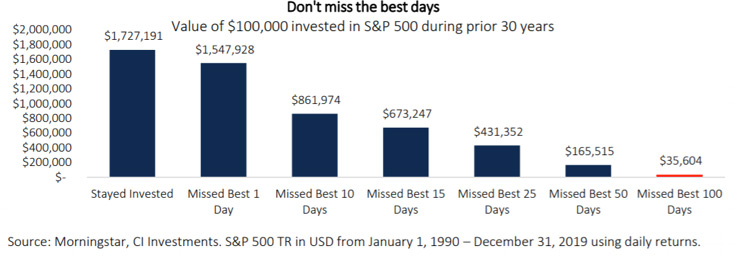We want to provide you with a quarterly update and information on how the COVID-19 pandemic has affected financial markets.
The first quarter of 2020 was unlike any we have seen in a very long time. In response to the pandemic and the social distancing and lockdown measures that have affected over one-third of the world’s population, global capital markets declined sharply. Energy prices also weakened significantly as a result of a price war between Russia and Saudi Arabia, further affecting the shares of energy companies and adding to the general atmosphere of anxiety in the markets. This was a stark contrast to the decade of gains investors had experienced since the end of the financial crisis. In fact, North American stock markets had reached all-time highs in February, on the heels of their strongest year since 2013.
The S&P 500 Index, a broad measure of U.S. equities, had the worst start to a year in history, down 20% (in U.S. dollars) over the three months ending March 31, while the Canadian S&P/TSX Composite Index posted its worst quarter since the financial crisis, declining 21.6%. Government bonds benefited from investors moving to safe havens, and yields moved lower as prices rose. The Canadian dollar declined in value over the quarter, helping to mitigate losses for Canadians invested in U.S. markets.
As businesses were ordered closed to help stem the spread of the virus, central banks moved quickly to respond to the downturn with policies aimed at stabilizing the financial system, while the G7 countries announced that they would be willing to use “all appropriate policy tools” to provide economic support during the COVID-19 outbreak. Amidst surging unemployment numbers in both Canada and the U.S., the U.S. unveiled a US$2-trillion stimulus package, while the Canadian government’s commitment to fiscal support reached C$176 billion. The U.S. Federal Reserve (Fed) made two emergency cuts to its policy rate, bringing it to a range of 0-0.25%, while The Bank of Canada made three rate cuts to reduce its overnight lending rate to 0.25%.
Certainly, this has been a very difficult period, and you may be anxious about your investments as well as your own health and the health of your loved ones. There are still many unknowns about the virus and the economic impact of the measures being taken to control it. However, it is at these times of great uncertainty that discipline and the ability to remove emotion from one’s financial decisions becomes an investor’s most valuable asset. I believe that your trust in me to oversee your investments objectively will prove beneficial as we come out of this correction. As history has demonstrated, markets have ultimately recovered from setbacks, large and small, before moving higher in the long run.
You can take some comfort in the fact that the portfolio we have built together is diversified and constructed to withstand the market shocks we are currently experiencing. A well-diversified portfolio geared toward your financial goals and risk tolerance remains the best approach to dealing with volatility and offers one of the best opportunities to participate in the inevitable market recovery.
I want to leave you with a chart that demonstrates the importance of staying invested throughout downturns, and the risks of trying to time recoveries. While I may have shared this with you in the past, it illustrates the point so well that I believe there is no harm in seeing it again.

| Source: Morningstar®, CI Investments. S&P 500 TR in USD from January 1, 1990 – December 31, 2019 using daily returns. |
In closing, I would like to wish you and your family well during this unique time in all our lives. Remember I am just a phone call away, so if you have any questions about your portfolio and investment plan, please contact me at (604) 662-5511
Sources: CI Investments, Insider Inc., Morningstar, Bloomberg, Yahoo Canada Finance, Trading Economics, TD Newcrest and PC Bond.
